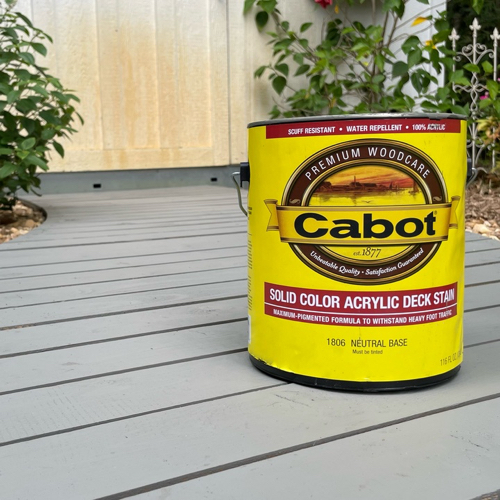
In our backyard we have this pretty convenient little garden shed where I store my lawn tools and some odds and ends, but in rainy Florida the mulch and fallen bamboo leaves make for an ugly and dirty path in and out of it so I needed a solution.
In the past I have done flagstones or gravel but this time I took inspiration from the amazing wrap around porch on my 1918 house and decided to go with a wooden garden path. And like anything I build I wanted to create something that was DIY friendly so anyone with a little tool knowledge can build it too.
So, I partnered up once again with my friends at Cabot who sponsored this post to teach you how to make a DIY garden path for your own house. Let’s get to it!
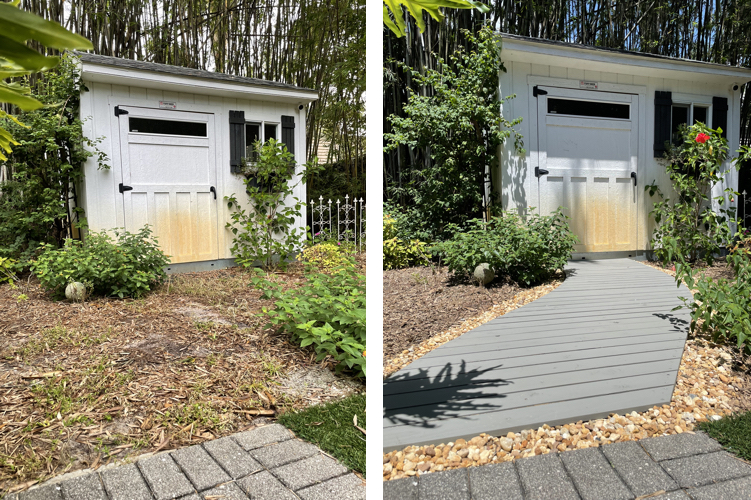
Building a Wooden Garden Path
Any wooden garden path will get brutalized by the weather so using a rot-resistant, but beautiful wood is important. For the walk path I decided to use western red cedar which is not only relatively rot-resistant, but also has a beautiful grain to it.
For the supports underneath I used some composite deck boards laminated together. I went this route because of the tight curves and the fact that the supports would be sunk into the dirt and any wood would not survive long in this scenario.
And most importantly I wanted to protect my garden path for a long life so I used Cabot Solid Color Acrylic Deck Stain which provides excellent protection for exterior woodwork. It goes on like paint but adheres like a stain and helps fight mildew which my project needs help with here in Florida.
Step #1 Ground Prep
I began by clearing the ground that I was planning on working on. I had to clear out some rocks and make sure the dirt was dug out enough to accommodate the supports which would be partially buried in the dirt.
I also needed to make sure the level would transition smoothly from my paver path to the door of the shed so I didn’t create a trip hazard and it remained easy to get my lawnmower in and out every weekend.
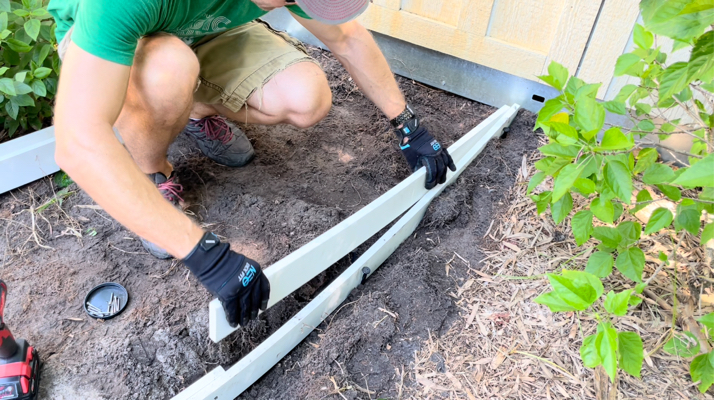
Step #2 Layout
I dug out trenches for each of the three supports and once the ground was prepped I laid out the supports in the design I wanted. This path was going to have some serious curves in the design and I knew that there wasn’t a wood product that would be both rot-resistant and flexible enough to create these curves so instead I opted for PVC trim boards.
These boards are extremely flexible and pretty much rot-proof, and since they would be buried in the dirt no one would ever see them. I bent them to fit the design I wanted which was pretty simple and used plastic garden stakes to hold them in place before surrounding them with dirt.
I scabbed two boards together using stainless steel screws for each of the three supports I was going to be needing. My path was going to be about 36” wide so having one support on each side as well as a center support would help avoid sagging treads later. I made sure everything was level side to side using a 4’ level.
Step #3 Attaching the Walk Path
Rather than laying out the boards at odd angles to follow the curved design of the path I decided to lay them parallel to the shed and ran them long so that I could trim them afterward. This results in far fewer cuts and I recommend it heartily. Just make sure your boards are long enough because as the curve gets more pronounced you’ll need longer treads.
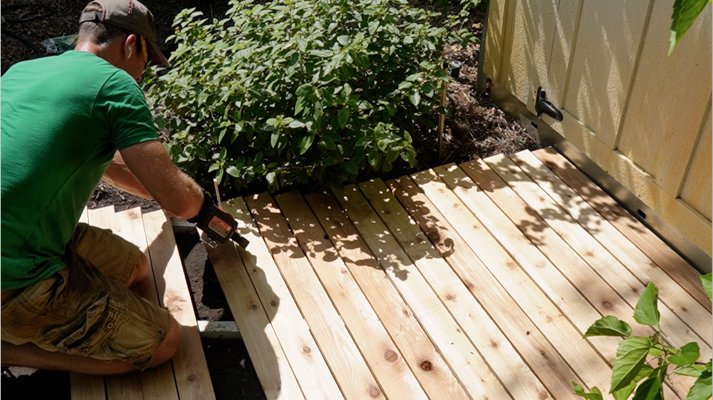
Handling a rough and splintery wood like western red cedar is always rough and because of that I made sure I was wearing my DEX FIT Mechanic Gloves. They protect my hands from the inevitable splinters and little cuts common in my work. And unlike other gloves I’m not helpless to answer my phone or use the calculator while working since the gloves are touchscreen compatible which makes them extremely convenient.
I started laying out each board using a carpenter’s pencil as a ¼” spacer. I started at the shed and moved down the line temporarily attaching each board with a stainless steel brad nail to make sure the alignment was right before screwing each board into the supports below with a couple stainless steel decking screws on each side and one in the middle support.
I then marked a ½” overlap using that same carpenter’s pencil to measure the overlap beyond the supports on each side. Since it was a curved path I needed to mark each board individually and couldn’t use a straight edge or chalk line. Then I came through with my circular saw and cut the boards to match my curved marks. The result was so gorgeous!
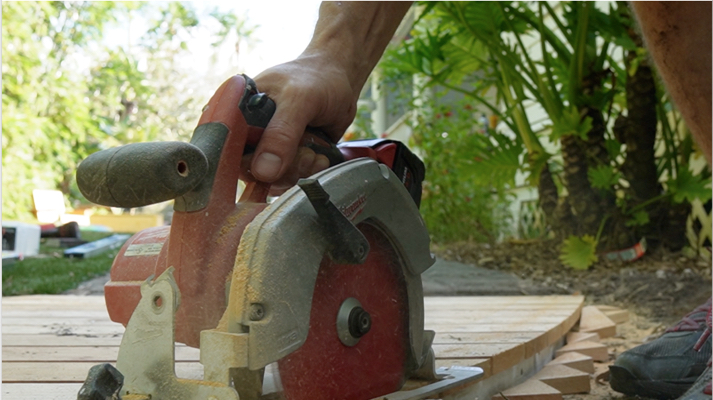
Step #4 Staining the Garden Path
It was important for me to tie in my garden path to the same look of the porch on my house so I used Cabot Solid Color Acrylic Deck Stain on the boards in Pewter Grey. I’ve always loved Cabot products for outdoor projects because they can hold up to the brutal summer weather we have down here in Florida and this garden path was no different.
To apply the Cabot stain I used a 3” synthetic bristle brush since this is an acrylic stain. I applied the stain in the direction of the grain making sure not to over apply product which can cause excess build up on the surface (a common application error with wood stains like this). The stain only requires 1 coat and 4-6 hrs of drying time, but I let it dry overnight for good measure.
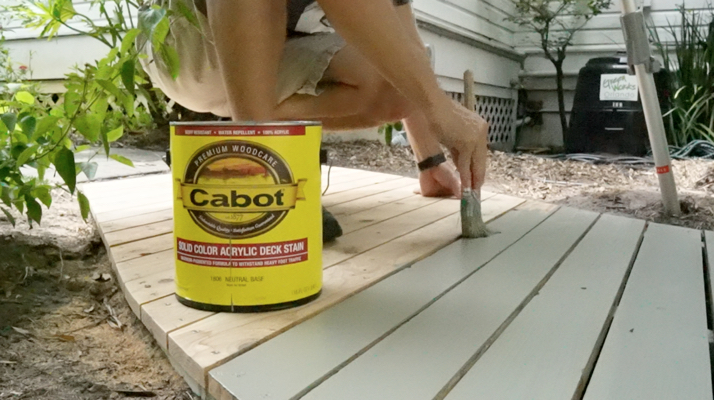
It was a sunny day when I was staining and to avoid applying in direct sunlight like Cabot recommends I used a large umbrella to keep my workspace shady.
I’ve used Cabot’s oil-based stains in previous projects like my DIY Adirondack Chair and Rot-Proof Garden Bed, but this was my first time using their acrylic solid stains and I have to say I was impressed with the ease of application and especially the simple clean up of a water based acrylic.
The solid stain may look like it is a paint, but it is actually a stain which makes it better for this outdoor project. A stain penetrates deeper into the wood and will hold up better against peeling than a traditional paint would on this project because of the harsh exposure. Not to mention you don’t need to prime the wood first. Can you say “time-saver”?
Finishing Up
After a couple days of rest I was ready to put my new DIY garden path to work on lawn mowing day and I have to say it didn’t disappoint. I added some river rocks on the sides to better hide the supports and give the path a more seamless transition to the rest of the garden.
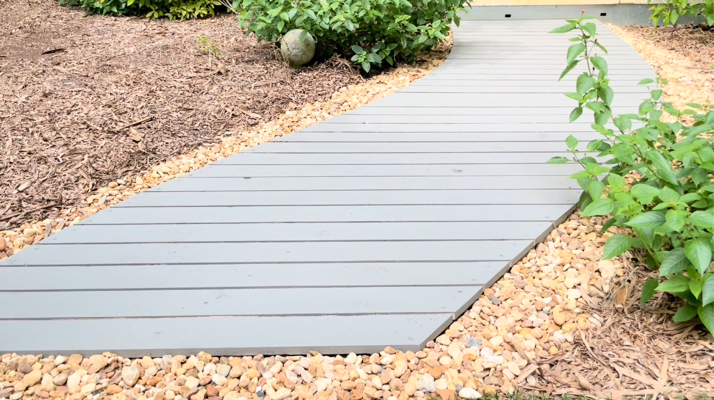
I love the way it dressed up our backyard as it wound through our butterfly garden and provided a practical way to get in and out of the garden shed without getting muddy feet.
My favorite part of this is how simple the whole project was. I was able to finish the whole thing with all the complex curves in just one day. A DIYer with a relatively straight path could complete this in just one day no problem.
If I’ve inspired you to add a garden path to your home then definitely consider using a natural wood like I did because there is just no comparison to the fake composite looking products. It’s cooler on your bare feet than composite, more natural and can be made into almost any color with the help of Cabot stains like I used.
If you’d like to learn more about Cabot’s products for your outdoor projects you can check them out here.
Subscribe Now For Your FREE eBook!

Founder & Editor-in-Chief
I love old houses, working with my hands, and teaching others the excitment of doing it yourself! Everything is teachable if you only give it the chance.


I have a California deck that got too dense a stain that makes the redwood looks more like a painted surface, HJOw to go back to stain?